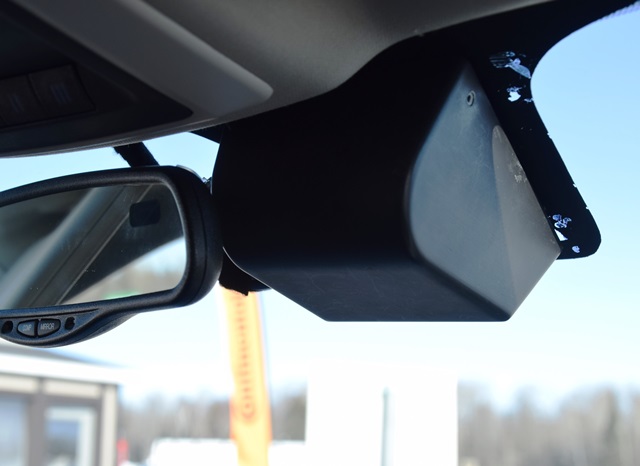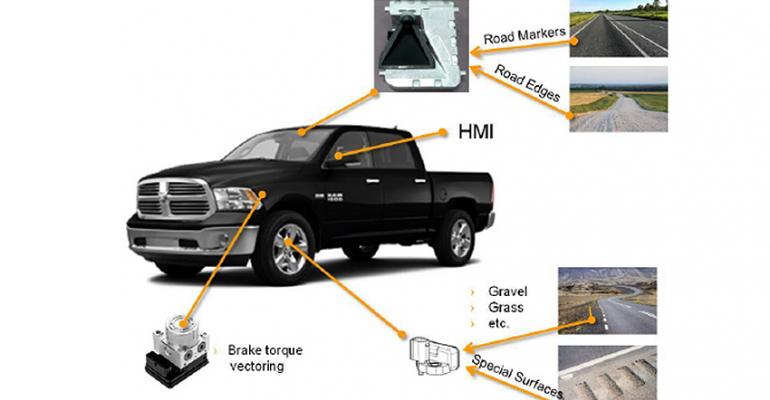A vehicle that stays on the road, within its lane, headed in its intended direction, most likely will avoid a collision, so German supplier Continental has developed a new technology to help vehicles stay on the straight and narrow.
Its recently unveiled Road Departure Protection system, coming to market within six years, is designed to be more robust than lane-departure warning systems already in the market.
If a driver is drifting out of his lane without activating the turn signal, a LDW system generally will provide an audible alert or vibrate the steering wheel to get the driver’s attention. Some systems are able to steer the vehicle back into its intended lane.
Still, some 55% of fatal accidents in the U.S. are caused by a vehicle leaving the roadway or crossing the center line and striking an object, a pedestrian or another vehicle.
These are the accidents Continental’s new road departure system is designed to prevent.
It uses an intelligent third-generation mono camera (mounted near the rear-view mirror) to gather more information about the road ahead.
Overall, the system is designed to intervene more aggressively by using brakes and steering to prevent a vehicle from drifting laterally, acting like a virtual guard rail.
“When we have a camera in the car for traffic-sign recognition, for example, or high-beam control or for lane-departure warning, we can use it for additional things to protect the vehicle from departing the road,” Andrew Attard, Continental’s new business development director for North America, tells WardsAuto in demonstrating the technology in a Ram pickup.
The camera can determine the color and type of lane marker, allowing the system to better identify the edge of the road. “If it’s a solid or a dashed line, that’s already strong information that it might be the edge of the road,” he says.
Chassis sensors (accelerometers and wheel speed sensors) also play a role in the system by identifying changes in road surface roughness.
“If I transition from asphalt to a rumble strip or asphalt to a gravel shoulder, for example, that gives us additional information that what just happened is crossing the edge of the road,” Attard says. “Once I know it’s the edge of the road, now it can steer the vehicle back and keep it safe.”
System Uses Existing Hardware
The technology has its limitations. For instance, snow and ice building up between lanes and along the roadside make it difficult to identify lane markings.
“It’s a visual system,” Attard says. “As humans do, when the road is covered with snow or partially covered, it’s difficult to see the line or the actual edge of the road, which is why we try to look for as many independent pieces of information as possible.”

With enough information suggesting the vehicle is leaving the roadway, the electronic stability control (now standard in the U.S.) will gently apply brakes to the inside wheels, acting like a torque-vectoring system in nudging the vehicle back into its lane.
In dire situations, the brakes can work in tandem with electric power steering, if a vehicle is so equipped, to keep the vehicle safely on the intended path.
Attard likes that the system is biased toward activating brakes on specific wheels because it provides haptic feedback to the driver.
“So if you were falling asleep, that haptic intervention also serves to wake you up potentially,” he says. “And it also decelerates the vehicle, so if it does collide with something, it would reduce the energy of impact.”
Because it is designed to be active whenever the vehicle is running, Attard considers the road departure system much more sophisticated than other LDW technologies already in the market because those can be turned off.
“If you can turn it off, then it won’t be effective if you fall asleep,” he says. “We try to wake you up, but maybe you don’t for whatever reason. This is the safety net behind, to really keep the vehicle from departing the edge of the road.”
Attard says most LDW systems provide “soft intervention, not enough to actually keep the vehicle from leaving the lane at a high departure angle, for example. It should never intervene during normal situations.”
He sees this next-generation system gaining acceptance in the market because most of the functionality is software-driven and does not require additional hardware or cameras.





